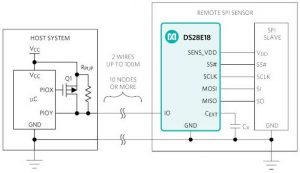Bridge chip links one-wire bus to ten I2C or SPI peripherals
MOYA-TECH 2020-11-12
Maxim has introduced a chip to interface devices equipped with I2C or SPI bus connections to its ‘1-wire’ bus.

Called DS28E18, it is intended to knock cost out of networks that connecting I2C and SPI sensors to a host by reducing the number of copper wires needed for up to 10 nodes to two wires.
Busses over 100m long are possible.
“As sensors become more prevalent in a number of applications, so does the need to extend connectivity over longer distances,” said Maxim embedded security director Scott Jones. “To cost effectively extend the operating distance for serial interface devices invokes a great deal of complexity but using 1-Wire protocol greatly simplifies these networks with simpler software and fewer cables and ICs.”
Rather than simply re-code data on the six wire SPI bus or four I2C to the 1-wire protocol, the IC provides a 512-byte command sequencer in SRAM that can be loaded with multiple I2C or SPI commands.
Once loaded, the host controller sends commands to execute these sequences, which write to, or collect data from, attached I2C or SPI peripherals. A subsequent 1-Wire command reads collected data.
One reason for this triggered sequence approach is that the 1-wire bus main interface has no hope of keeping up with the raw data rate of its slave interface – the 1-wire interface works at 11kbit/s (‘standard’) or 90kbit/s (‘overdrive’), while the chip’s other interface will cope with 100kHz, 400kHz or 1MHz I2C slaves, or SPI slaves at rates up to 2.3MHz.
Configuring for I2C or SPI operation is performed with a 1-wire command (I2C is power-on default).
In I2C mode, two programmable GPIO pins are available for additional peripheral control.
Power for attached sensors or peripherals, within limits, can be sourced from the 1-wire bus “making the DS28E18 a very efficient solution to remotely power and control complex I2C or SPI devices such as sensors, ADCs, DACs and display controllers,” according to the company.
Each DS28E18 also provides a unique and secure 64bit ROM identification number that serves as the device’s bus address.
Multiple DS28E18 devices can coexist with other devices in a 1-wire network and be accessed individually.
Operation is across -40°C to +85°C, and 2.97 to 3.63V.
Packaging is 2 x 3 x 0.75mm, 8pin TDFN.
